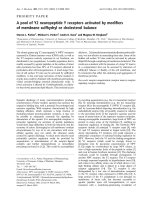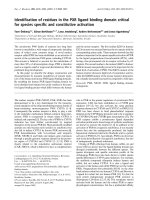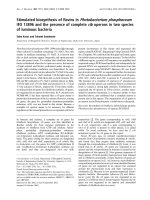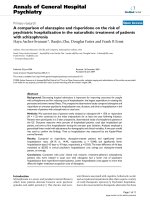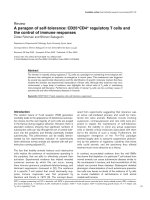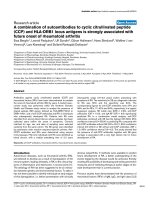Báo cáo y học: "A meta-analysis of the incidence of malignancy in adult patients with rheumatoid arthritis" doc
Bạn đang xem bản rút gọn của tài liệu. Xem và tải ngay bản đầy đủ của tài liệu tại đây (583.55 KB, 8 trang )
Open Access
Available online />Page 1 of 8
(page number not for citation purposes)
Vol 10 No 2
Research article
A meta-analysis of the incidence of malignancy in adult patients
with rheumatoid arthritis
Allison L Smitten
1
, Teresa A Simon
2
, Marc C Hochberg
3
and Samy Suissa
4
1
Duke University School of Medicine, Duke South, Durham, NC, 27710 USA
2
Global Pharmacovigilance and Epidemiology, Bristol-Myers Squibb Company, 311 Pennington-Rocky Hill Road; Hopewell, NJ, 08534 USA
3
Division of Rheumatology and Clinical Immunology, University of Maryland School of Medicine, 10 S. Pine St., MSTF 8-34; Baltimore, MD, 21201
USA
4
Division of Clinical Epidemiology, McGill University Health Centre, Royal Victoria Hospital; 687 Pine Ave West, R4.29; Montreal, QC, H3A 1A1
Canada
Corresponding author: Samy Suissa,
Received: 30 Aug 2007 Revisions requested: 8 Oct 2007 Revisions received: 5 Mar 2008 Accepted: 23 Apr 2008 Published: 23 Apr 2008
Arthritis Research & Therapy 2008, 10:R45 (doi:10.1186/ar2404)
This article is online at: />© 2007 Smitten et al.; licensee BioMed Central Ltd.
This is an open access article distributed under the terms of the Creative Commons Attribution License ( />),
which permits unrestricted use, distribution, and reproduction in any medium, provided the original work is properly cited.
Abstract
Introduction The risk of malignancies in patients with
rheumatoid arthritis (RA) has raised some concern, particularly
with immunosuppressive approaches to disease management.
Methods We conducted a systematic review of the literature
and meta-analysis characterizing the associated risk of overall
malignancy and four site-specific malignancies (lymphoma, lung,
colorectal, and breast cancer) in patients with RA. A Medline
search from 1990 to 2007 was conducted using specified
search terms and predefined inclusion criteria for identification
of relevant observational studies that provide estimates of
relative risk of malignancy associated with RA. Study-specific
estimates of the relative risk, as measured by standardized
incidence ratios (SIRs) and estimated in comparison with the
general population, were combined using a random effects
model.
Results A total of 21 publications were identified, of which 13
reported the SIR for overall malignancy, 14 for lymphoma, 10 for
colorectal, 12 for lung, and 9 for breast cancer. Compared with
the general population, the overall SIR estimates suggest that
RA patients have approximately a two-fold increase in lymphoma
risk (SIR 2.08, 95% confidence interval [CI] 1.80 to 2.39) and
greater risk of Hodgkin than non-Hodgkin lymphoma. The risk of
lung cancer was also increased with an SIR of 1.63 (95% CI
1.43 to 1.87). In contrast, a decrease in risk was observed for
colorectal (SIR 0.77, 95% CI 0.65 to 0.90) and breast (SIR
0.84, 95% CI 0.79 to 0.90) cancer. The SIR for overall
malignancy was 1.05 (95% CI 1.01 to 1.09).
Conclusion Patients with RA appear to be at higher risk of
lymphoma and lung cancer and potentially decreased risk for
colorectal and breast cancer compared with the general
population.
Introduction
Rheumatoid arthritis (RA) is a chronic autoimmune disease
that is also characterized by the presence of inflammation.
Because of the immune pathways underlying its pathogenesis
and what has generally been an immunosuppressive approach
to disease management using traditional disease-modifying
antirheumatic drugs (DMARDs), the risk of malignancies
among RA patients has been of considerable interest. The
characterization of this potential risk has become more rele-
vant with the introduction of a new class of agents, biologic
DMARDs. While these drugs act by directly modifying immu-
nologic pathways involved in the pathogenesis of RA, it has
been of concern that their use may be associated with an
increased incidence of cancer. To better understand and inter-
pret studies evaluating the risk associated with these agents,
it is first necessary to determine the magnitude of any underly-
ing risk of cancer that may already be present in patients with
RA compared with the general population.
Data from several studies, reviewed by Chakravarty and Gen-
ovese [1], have suggested that there is no increase in the over-
all risk of cancer in patients with RA compared with the
general population. However, accumulating evidence has sug-
gested that the RA population may be characterized by
CI = confidence interval; COX-2 = cyclooxygenase-2; DMARD = disease-modifying antirheumatic drug; NSAID = nonsteroidal anti-inflammatory
drug; RA = rheumatoid arthritis; SIR = standardized incidence ratio; TNF = tumor necrosis factor.
Arthritis Research & Therapy Vol 10 No 2 Smitten et al.
Page 2 of 8
(page number not for citation purposes)
changes in the relative risk of site-specific malignancies. Con-
sequently, the objective of this study was to review the risk of
four important site-specific malignancies (lymphoma, lung,
colorectal, and breast cancer) in patients with RA in the recent
published literature. In particular, this review focused on
observational studies comparing the incidence of malignancy
in patients with RA versus the general population since these
may be expected to provide a realistic perspective on risk in
the clinical setting.
Materials and methods
To identify studies characterizing the risk of malignancy in
patients with RA compared with the general population, a
Medline search was performed using the search terms 'rheu-
matoid arthritis' combined with 'cancer', 'malignancy OR
malignancies', 'neoplasm(s)', or 'lymphoma(s)'. The search
covered the publication period from January 1990 to Decem-
ber 2007 and included only English language publications.
Studies were eligible for inclusion if they fulfilled the following
criteria: (a) observational-type study design (including pro-
spective, retrospective, epidemiologic, database, survey, reg-
istry, cohort, and case-control), (b) more than 100 patients, (c)
adult population, and (d) geographic regions including North
America, South America, Europe, Australia, New Zealand, and
Japan. Citations meeting the inclusion criteria were obtained
and screened for the outcomes of interest, which included the
observed incidence rates of total malignancy, lymphoma, lung,
colorectal, and breast cancer in patients with RA compared
with the expected incidence rates in the general population.
Lymphoma was reported as Hodgkin or non-Hodgkin where
available. The selection of studies for inclusion was made with-
out regard to evaluation of specific RA management strate-
gies. We attempted to avoid overlap by excluding studies for
which updated manuscripts were available.
The preferred method of data presentation was the calculated
relative risk compared with the general population, generally
estimated as the age- and gender-adjusted standardized inci-
dence ratio (SIR) and sometimes referred to as a standardized
morbidity ratio. The SIR provides a point estimate of relative
risk and is accompanied by a 95% confidence interval (CI). In
situations in which SIRs were not specifically reported, they
were calculated from the observed and expected incidence
rates presented in the study (SIR = number of observed malig-
nancies per number of expected malignancies), and a 95% CI
was determined assuming that the frequency of observed
cases followed a Poisson distribution. For the meta-analysis,
summary estimates and 95% CIs were calculated based on
the method of DerSimonian and Laird [2]. This method uses a
random effects model that considers both within-study and
between-study variation by incorporating the heterogeneity of
effects in the overall analysis.
Results
A total of 2,093 articles were identified using the defined
Medline search criteria, and these titles and abstracts were
screened to identify potentially relevant articles. A total of 106
publications were further analyzed for the presence of the
inclusion criteria, and, of these, 21 publications from 16
diverse studies (Additional file 1) met all inclusion criteria [3-
23]. These studies included population- and community-
based RA cohorts that ranged from 144 to 76,527 patients
and had mean follow-up times of 1 to 17.4 years. There was
slight overlap in the patient populations included in two stud-
ies from Sweden [4,5,7].
Of these studies, 13 reported the relative risk for overall malig-
nancy, 12 for lung cancer, 10 for colorectal cancer, and 9 for
breast cancer. The relative risk of lymphoma was reported in
14 studies; 6 studies reported overall lymphoma, 10 reported
non-Hodgkin lymphoma, and 8 reported Hodgkin disease.
All of the publications presented SIRs, but in two publications
the SIRs were stratified by gender, necessitating recalculation
of the SIRs for the combined population [12,21]. Figures 1 to
7 graphically present the SIRs and their 95% CIs from the indi-
vidual studies for the site-specific malignancies and overall
malignancy as well as the calculated point estimates and 95%
CIs from the random effects models of the combined studies.
Compared with the general population, the highest risk of a
site-specific malignancy in patients with RA was observed for
lymphoma regardless of lymphoma type. Despite the wide
range in relative risk, as shown in Figure 1 and based on the
random effects model, RA was associated with an overall two-
fold increase in lymphoma risk compared with the general pop-
ulation (SIR 2.08, 95% CI 1.80 to 2.39). A higher risk was
observed for Hodgkin lymphoma (Figure 2) than for non-Hodg-
kin lymphoma (Figure 3), with SIRs of 3.29 (95% CI 2.56 to
4.22) and 1.95 (95% CI 1.70 to 2.24), respectively.
In addition to lymphoma, lung cancer was more frequently
observed in patients with RA than in the general population
(Figure 4). With the exception of four studies having outlying
SIR values of 0 [19], 1.08 [6], 1.2 [23], and 12.4 [17], there
appeared to be a cluster of SIRs that suggested an approxi-
mate 1.5- to 3.5-fold increase in the risk of lung cancer, a
range that was supported by the random effects model which
resulted in an SIR of 1.63 (95% CI 1.43 to 1.87). In contrast,
the risk of colorectal cancer appeared to be somewhat
reduced in patients with RA (Figure 5). For colorectal cancer,
individual SIRs were generally less than 1, and the summary
estimate using the random effects model resulted in an overall
SIR of 0.77 (95% CI 0.65 to 0.90). Similarly, as shown in Fig-
ure 6, there appeared to be a slightly reduced risk of breast
cancer associated with RA. With one exception, all the
reported SIRs clustered just below risk parity with the general
population, and the summary estimate was 0.84 (95% CI 0.79
Available online />Page 3 of 8
(page number not for citation purposes)
Figure 1
Relative risk of overall lymphoma in patients with rheumatoid arthritis (RA) compared with the general populationRelative risk of overall lymphoma in patients with rheumatoid arthritis (RA) compared with the general population. CI, confidence interval; n, number
of malignancies; N, population size; SIR, standardized incidence ratio; TNF, tumor necrosis factor.
Figure 2
Relative risk of Hodgkin disease in patients with rheumatoid arthritis compared with the general populationRelative risk of Hodgkin disease in patients with rheumatoid arthritis compared with the general population. CI, confidence interval; MTX, methotrex-
ate; n, number of malignancies; N, population size; SIR, standardized incidence ratio.
Figure 3
Relative risk of non-Hodgkin lymphoma in patients with rheumatoid arthritis compared with the general populationRelative risk of non-Hodgkin lymphoma in patients with rheumatoid arthritis compared with the general population. CI, confidence interval; DMARDs,
disease-modifying antirheumatic drugs; MTX, methotrexate; n, number of malignancies; N, population size; SIR, standardized incidence ratio.
Arthritis Research & Therapy Vol 10 No 2 Smitten et al.
Page 4 of 8
(page number not for citation purposes)
Figure 4
Relative risk of lung cancer in patients with rheumatoid arthritis (RA) compared with the general populationRelative risk of lung cancer in patients with rheumatoid arthritis (RA) compared with the general population. CI, confidence interval; DMARDs, dis-
ease-modifying antirheumatic drugs; MTX, methotrexate; n, number of malignancies; N, population size; SIR, standardized incidence ratio; TNF,
tumor necrosis factor.
Figure 5
Relative risk of colorectal cancer in patients with rheumatoid arthritis (RA) compared with the general populationRelative risk of colorectal cancer in patients with rheumatoid arthritis (RA) compared with the general population. CI, confidence interval; DMARDs,
disease-modifying antirheumatic drugs; MTX, methotrexate; n, number of malignancies; N, population size; SIR, standardized incidence ratio; TNF,
tumor necrosis factor.
Figure 6
Relative risk of breast cancer in patients with rheumatoid arthritis (RA) compared with the general populationRelative risk of breast cancer in patients with rheumatoid arthritis (RA) compared with the general population. CI, confidence interval; DMARDs, dis-
ease-modifying antirheumatic drugs; MTX, methotrexate; n, number of malignancies; N, population size; SIR, standardized incidence ratio; TNF,
tumor necrosis factor.
Available online />Page 5 of 8
(page number not for citation purposes)
to 0.90). The exception, an SIR of 1.68, was in a Japanese
population and the authors state that they observed a gener-
ally higher risk of malignancies in Japanese women with RA
than that reported in comparable Caucasian cohorts [19].
In general, the SIRs from the various individual studies were
near parity for the risk of overall malignancies (Figure 7). The
random effects model provided a summary estimate of 1.05
(95% CI 1.01 to 1.09).
Several of the studies examined the risk of malignancy in
patients receiving biologic therapy [4,5,10,20,22,23]. In those
studies that specifically evaluated the effects of tumor necro-
sis factor (TNF) antagonists on lymphoma risk, there was a
higher risk in RA patients receiving anti-TNF therapy compared
with the general population, with SIRs of 2.9 [4] and 11.5 [10].
Several of the studies that were included in our analysis pre-
sented odds ratios for lymphoma in RA patients who received
anti-TNF therapy compared with RA patients who did not
receive anti-TNF therapy, and none showed a statistically ele-
vated risk associated with anti-TNF use [4,10,22]. Two studies
presented SIRs for overall malignancy and neither was signifi-
cant [5,10]. Askling and colleagues [5] presented SIRs for var-
ious solid tumors and reported no difference in patients with
RA who received anti-TNF medication compared with the
general population for lung and colorectal cancer, whereas the
SIR for breast cancer was decreased (SIR 0.4, 95% CI 0.2 to
0.9). Wolfe and Michaud [23] computed odds ratios to evalu-
ate the use of biologics in RA patients compared with non-use
and did not find an association between these medications
and overall malignancy (excluding non-melanoma skin), lung
cancer, breast cancer, or colorectal cancer.
Two of the studies included in our analysis evaluated malig-
nancy risk in an identified early RA population [4,5,8,9]. Ask-
ling and colleagues [4,5] found an increased risk of lymphoma
and lung cancer and a decreased risk of breast cancer in
patients with early RA compared with the general population;
they found no association with all solid tumors or colorectal
cancer. Franklin and colleagues [8,9] observed no increase in
overall malignancy excluding non-melanoma skin cancer but
saw an increase in lymphoma in their early RA population.
Discussion
The data reported here suggest that, although there is no
increased risk of overall malignancies in patients with RA
compared with the general population, there may be a defined
pattern of risk for site-specific malignancies. Based on
observed versus expected cases, there was considerable var-
iation in the calculated SIRs among the individual studies for
site-specific malignancies. Nevertheless, the random effects
meta-analysis demonstrated an overall pattern that was gener-
ally consistent with the risk trends reported in the individual
studies. This pattern included a clear increase in risks of lung
cancer and lymphoma, both Hodgkin and non-Hodgkin, and a
potential decrease in risks of colorectal cancer and breast
cancer.
The increased risk of lymphoma is especially notable since this
malignancy was associated with the highest relative risk, espe-
cially for Hodgkin lymphoma, which was more than three-fold
higher than in the general population. Although one study sug-
gested a decrease in lymphoma risk (an approximate 50%
reduction in non-Hodgkin lymphoma with no reported cases of
Hodgkin disease) [6], these results were ascribed to the rarity
of these malignancies and the small population that was
followed (n = 862), although other studies with similarly small
Figure 7
Relative risk of overall malignancies in patients with rheumatoid arthritis (RA) compared with the general populationRelative risk of overall malignancies in patients with rheumatoid arthritis (RA) compared with the general population. *Excluding non-melanoma skin;
†
all solid tumors;
‡
excluding lymphatic and hematopoetic. CI, confidence interval; DMARDs, disease-modifying antirheumatic drugs; MTX, methotrex-
ate; n, number of malignancies; N, population size; SIR, standardized incidence ratio; TNF, tumor necrosis factor.
Arthritis Research & Therapy Vol 10 No 2 Smitten et al.
Page 6 of 8
(page number not for citation purposes)
populations (that is, less than or equal to 800 patients)
seemed to follow the trends seen in our meta-analysis
[10,16,19].
There have been a number of hypothesized explanations for
the differences in the risk of certain malignancies in patients
with RA compared with patients without the disease. Possible
mechanisms for an increased risk of lymphoma in RA patients
include the fact that RA results in persistent immunologic stim-
ulation (which may lead to clonal selection and predispose
CD5
+
B cells to malignant transformation), decreases the
number and function of T-suppressor lymphocytes (including
those directed against the pro-oncogenic Epstein-Barr virus),
and decreases natural killer cell activity in the synovial fluid, tis-
sue, blood, and lymph [24]. Inflammation is believed to play a
key role in the risk of lymphoma; epidemiologic studies have
suggested that, among patients with RA, higher inflammatory
activity is a major risk determinant of lymphoma [25,26]. Mean-
while, the role of RA treatment remains somewhat uncertain;
large cohort studies have not confirmed any treatment-related
effects; however, it is premature to make conclusions about
the risk associated with anti-TNFs with the currently available
data [26]. It has been suggested that a minority of RA patients
(those with the worst disease) carry much of the increased risk
of lymphoma because of their disease rather than their treat-
ment [27].
The observed association between RA and lung cancer may
result from several factors. Cigarette smoking would explain an
indirect association between RA and lung cancer as smoking
is an independent risk factor for both conditions. The direct
causal association of RA with lung cancer may be mediated by
chronic inflammation and/or the presence of interstitial lung
disease. Systemic chronic inflammation has been reported to
be a risk factor for lung cancer [28]. A recent 10-year popula-
tion-based observational cohort study reported that baseline
serum C-reactive protein was significantly associated with
lung cancer, independent of smoking [29]. In addition, RA has
been shown to affect the lungs; autopsy studies have shown
some degree of interstitial lung disease in the majority of peo-
ple with RA [30] and the mortality from pulmonary disease in
RA is approximately twice that of the general population [31].
The explanation for the reduced risk of colorectal cancer is
most likely due to the increased use of nonsteroidal anti-inflam-
matory drugs (NSAIDs) and cyclooxygenase-2 (COX-2)-
selective inhibitors by patients with RA. These medications
have consistently been associated with a decreased risk of
colorectal cancer; a recent meta-analysis of all randomized
controlled trials and observational studies concluded that
COX-2 inhibitors and NSAIDs reduce the incidence of colonic
adenomas and that NSAIDs also reduce the incidence of
colorectal cancer [32]. The hypothesis underlying this protec-
tive association is thought to be the inhibition of COX-2 and
subsequently prostaglandin production [33].
The strength of this review is its reliance on real-world clinical
data obtained from observational studies rather than rand-
omized placebo-controlled trials that reflect a selected cohort
of patients. It provides precise estimates of the malignancy risk
in RA patients. However, there are some limitations in the indi-
vidual studies, as well as with the systematic review and meta-
analysis, which should be considered when interpreting the
data.
The primary limitation is the heterogeneity among studies in
terms of the data sources, populations examined, and study
designs. The diversity of study methodologies in some cases
may have resulted in bias. Such an example is the study by
Mariette and colleagues [15], which was not strictly cohort-
derived; it involved identification of new lymphoma cases
based on consultation between rheumatology and oncology
departments. Uncertainty regarding the size of the RA popula-
tion evaluated may account for their very high reported relative
risk of 7.4 for Hodgkin lymphoma. Sources of selection bias
may include the use of hospitalization records for identification
of populations.
Other limitations include the possibility of misclassification
and the wide variation in follow-up. There may have been mis-
classification of the inclusion of patients into the RA popula-
tions, and there may have been uncertainty surrounding the
diagnostic accuracy of the malignancies. Several of the stud-
ies were dependent on database analyses and relied on diag-
nostic codes, whereas another used patient self-report
followed by medical record validation. Follow-up times ranged
from 1 year to as long as 17 years, and it is possible that in
some cases the variability observed in the SIRs may result
from these differences. However, these individual study limita-
tions may be compensated for, in part, within the context of
performing such a meta-analysis as presented here.
The analysis presented does not attempt to determine causal-
ity of risk or adjust for other risk factors that may contribute to
the observed increases or decreases in risks, as these data
were not readily available in the individual studies. This is espe-
cially relevant with respect to severity of disease as well as RA
treatment. In relation to treatment effects, nearly all patients in
these studies have received treatment for their RA, and it is
becoming increasingly likely that treatment of RA is initiated
early in the disease process. Consequently, it is difficult to
separate the underlying risk associated exclusively with the
disease from some of the potential treatment effects, espe-
cially when many patients may be taking multiple medications
for RA as well as for comorbid conditions. Nevertheless, the
consistent findings among the studies included in this meta-
analysis where patients were taking diverse medications are
consistent with the recent suggestion that it is the underlying
inflammation rather than treatment that contributes to the risk
[25,26].
Available online />Page 7 of 8
(page number not for citation purposes)
Conclusion
Despite the limitations, a clear trend toward a higher risk of
lymphoma and lung cancer was observed in patients with RA.
Although a potentially decreased risk of colorectal and breast
cancer was identified from the accumulated data in these
studies, this observation requires confirmation. Further studies
evaluating specific risk factors such as RA management strat-
egies, lifestyle factors, and the presence of the inflammatory
process that contributes to RA can help provide additional
information on the underlying mechanisms for the observed
changes in malignancy risk relative to the general population.
Competing interests
This study was funded by Bristol-Myers Squibb Company
(Hopewell, NJ, USA). SS has been reimbursed less than
$10,000 by Bristol-Myers Squibb Company and sanofi-
aventis (Paris, France) for honoraria and Scientific Advisory
Board Meetings. TAS is an employee of Bristol-Myers Squibb
Company. ALS is a consultant of Bristol-Myers Squibb
Company and has received more than $10,000 in consulting
fees. MCH is a consultant for Bristol-Myers Squibb Company
and has received less than $10,000 in consulting fees.
Authors' contributions
ALS conducted the literature search and helped to draft the
manuscript. TAS participated in the design and coordination
of the study and helped to draft the manuscript. MCH contrib-
uted to the interpretation of the data and helped to draft the
manuscript. SS performed the meta-analysis, participated in
the evaluation of studies for inclusion, and helped to draft the
manuscript. All authors read and approved the final
manuscript.
Additional files
Acknowledgements
The authors thank Lili Wang, who provided research assistance and
helpful discussions.
References
1. Chakravarty EF, Genovese MC: Associations between rheuma-
toid arthritis and malignancy. Rheum Dis Clin North Am 2004,
30:271-284.
2. DerSimonian R, Laird N: Meta-analysis in clinical trials. Control
Clin Trials 1986, 7:177-188.
3. Abásolo L, Júdez E, Descalzo MA, González-Álvaro I, Jover JA, Car-
mona L, EMECAR Study Group: Cancer in rheumatoid arthritis:
occurrence, mortality, and associated factors in a south Euro-
pean population. Semin Arthritis Rheum in press. 2007 Oct 29
4. Askling J, Fored CM, Baecklund E, Brandt L, Backlin C, Ekbom A,
Sundström C, Bertilsson L, Cöster L, Geborek P, Jacobsson LT,
Lindblad S, Lysholm J, Rantapää-Dahlqvist S, Saxne T, Klareskog
L, Feltelius N: Haematopoietic malignancies in rheumatoid
arthritis: lymphoma risk and characteristics after exposure to
tumour necrosis factor antagonists. Ann Rheum Dis 2005,
64:1414-1420.
5. Askling J, Fored CM, Brandt L, Baecklund E, Bertilsson L, Feltelius
N, Cöster L, Geborek P, Jacobsson LT, Lindblad S, Lysholm J, Ran-
tapää-Dahlqvist S, Saxne T, Klareskog L: Risks of solid cancers
in patients with rheumatoid arthritis and after treatment with
tumour necrosis factor antagonists. Ann Rheum Dis 2005,
64:1421-1426.
6. Cibere J, Sibley J, Haga M: Rheumatoid arthritis and the risk of
malignancy. Arthritis Rheum 1997, 40:1580-1586.
7. Ekström K, Hjalgrim H, Brandt L, Baecklund E, Klareskog L, Ekbom
A, Askling J: Risk of malignant lymphomas in patients with
rheumatoid arthritis and in their first-degree relatives. Arthritis
Rheum 2003, 48:963-970.
8. Franklin J, Lunt M, Bunn D, Symmons D, Silman A: Incidence of
lymphoma in a large primary care derived cohort of cases of
inflammatory polyarthritis. Ann Rheum Dis 2006, 65:617-622.
9. Franklin J, Lunt M, Bunn D, Symmons D, Silman A: Influence of
inflammatory polyarthritis on cancer incidence and survival:
results from a community-based prospective study. Arthritis
Rheum 2007, 56:790-798.
10. Geborek P, Bladström A, Turesson C, Gulfe A, Petersson IF,
Saxne T, Olsson H, Jacobsson LT: Tumour necrosis factor
blockers do not increase overall tumour risk in patients with
rheumatoid arthritis, but may be associated with an increased
risk of lymphomas. Ann Rheum Dis 2005, 64:699-703.
11. Gridley G, McLaughlin JK, Ekbom A, Klareskog L, Adami HO,
Hacker DG, Hoover R, Fraumeni JF Jr: Incidence of cancer
among patients with rheumatoid arthritis. J Natl Cancer Inst
1993, 85:307-311.
12. Kauppi M, Pukkala E, Isomaki H: Excess risk of lung cancer in
patients with rheumatoid arthritis. J Rheumatol 1996,
23:1484-1485.
13. Kauppi M, Pukkala E, Isomaki H: Low incidence of colorectal can-
cer in patients with rheumatoid arthritis. Clin Exp Rheumatol
1996, 14:551-553.
14. Kauppi M, Pukkala E, Isomaki H: Elevated incidence of hemato-
logic malignancies in patients with Sjögren's syndrome com-
pared with patients with rheumatoid arthritis (Finland). Cancer
Causes Control 1997, 8:201-204.
15. Mariette X, Cazals-Hatem D, Warszawki J, Liote F, Balandraud N,
Sibilia J: Lymphomas in rheumatoid arthritis patients treated
with methotrexate: a 3-year prospective study in France.
Blood 2002, 99:3909-3915.
16. Matteson EL, Hickey AR, Maguire L, Tilson HH, Urowitz MB:
Occurrence of neoplasia in patients with rheumatoid arthritis
enrolled in a DMARD Registry. Rheumatoid Arthritis Azathio-
prine Registry Steering Committee. J Rheumatol 1991,
18:809-814.
17. McKendry RJ, Dale P: Adverse effects of low dose methotrex-
ate therapy in rheumatoid arthritis. J Rheumatol 1993,
20:1850-1856.
18. Mellemkjaer L, Linet MS, Gridley G, Frisch M, Moller H, Olsen JH:
Rheumatoid arthritis and cancer risk. Eur J Cancer 1996,
32A:1753-1757.
19. Moritomo H, Ueda T, Hiyama T, Hosono N, Mori S, Komatsubara
Y: The risk of cancer in rheumatoid patients in Japan. Scand J
Rheumatol 1995, 24:157-159.
20. Setoguchi S, Solomon DH, Weinblatt ME, Katz JN, Avorn J, Glynn
RJ, Cook EF, Carney G, Schneeweiss S: Tumor necrosis factor
alpha antagonist use and cancer in patients with rheumatoid
arthritis. Arthritis Rheum 2006, 54:2757-2764.
21. Thomas E, Brewster DH, Black RJ, Macfarlane GJ: Risk of malig-
nancy among patients with rheumatic conditions. Int J Cancer
2000, 88:497-502.
22. Wolfe F, Michaud K: The effect of methotrexate and anti-tumor
necrosis factor therapy on the risk of lymphoma in rheumatoid
arthritis in 19,562 patients during 89,710 person-years of
observation. Arthritis Rheum 2007, 56:1433-1439.
23. Wolfe F, Michaud K: Biologic treatment of rheumatoid arthritis
and the risk of malignancy: analyses from a large US observa-
tional study. Arthritis Rheum 2007, 56:2886-2895.
The following Additional files are available online:
Additional file 1
Table 1. Characteristics of included studies
See />supplementary/ar2404-S1.doc
Arthritis Research & Therapy Vol 10 No 2 Smitten et al.
Page 8 of 8
(page number not for citation purposes)
24. Georgescu L, Quinn GC, Schwartzman S, Paget SA: Lymphoma
in patients with rheumatoid arthritis: association with disease
state or methotrexate treatment. Semin Arthritis Rheum 1997,
26:794-804.
25. Baecklund E, Iliadou A, Askling J, Ekbom A, Backlin C, Granath F,
Catrina AI, Rosenquist R, Feltelius N, Sundström C, Klareskog L:
Association of chronic inflammation, not its treatment, with
increased lymphoma risk in rheumatoid arthritis. Arthritis
Rheum 2006, 54:692-701.
26. Smedby KE, Baecklund E, Askling J: Malignant lymphomas in
autoimmunity and inflammation: a review of risks, risk factors,
and lymphoma characteristics. Cancer Epidemiol Biomarkers
Prev 2006, 15:2069-2077.
27. Askling J: Malignancy and rheumatoid arthritis. Curr Rheumatol
Rep 2007, 9:421-426.
28. Strauss GM: Cigarette smoking and other risk factors for lung
cancer. In UpToDate Edited by: Rose BD. Waltham,
MA:UpToDate; 2007.
29. Siemes C, Visser LE, Coebergh JW, Splinter TA, Witteman JC, Uit-
terlinden AG, Hofman A, Pols HA, Stricker BH: C-reactive protein
levels, variation in the C-reactive protein gene, and cancer risk:
the Rotterdam Study. J Clin Oncol 2006, 24:5216-5222.
30. Walker WC, Wright V: Pulmonary lesions and rheumatoid
arthritis. Medicine 1968, 47:501-520.
31. Pincus T, Callahan LF: Early mortality in RA predicted by poor
clinical status. Bull Rheum Dis 1992, 41:1-4.
32. Rostom A, Dubé C, Lewin G, Tsertsvadze A, Barrowman N, Code
C, Sampson M, Moher D, U.S. Preventive Services Task Force:
Nonsteroidal anti-inflammatory drugs and cyclooxygenase-2
inhibitors for primary prevention of colorectal cancer: a sys-
tematic review prepared for the U.S. Preventive Services Task
Force. Ann Intern Med 2007, 146:376-389.
33. Subungkot S, Frame D, Leslie W, Drajer D: Selective cyclooxyge-
nase-2 inhibition: a target in cancer prevention and treatment.
Pharmacotherapy 2003, 23:9-28.

